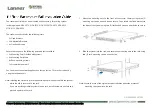
13
Bind different application templates to different interfaces.
You cannot bind both a POS terminal template and a POS application template to the same interface.
You can use this command on a synchronous/asynchronous interface only when the interface is
operating in asynchronous mode. If you bind an application template to an interface not operating in
asynchronous mode, the state of the application template is
Error
.
Examples
# Create POS application template 2 in flow mode.
<Sysname> system-view
[Sysname] posa app 2 type flow
[Sysname-posa-app2] quit
# Bind interface Async 1/0 to POS application template 2.
<Sysname> system-view
[Sysname] interface async1/0
[Sysname-Async1/0] posa bind app 2
Related commands
posa app
posa bind terminal
Use
posa bind terminal
to configure the current interface as the access interface of a POS terminal
template by binding the POS terminal to the interface.
Use
undo posa bind terminal
to remove the configuration.
Syntax
posa bind terminal
terminal-id
[
app
app-id
]
undo posa bind terminal
Default
An interface is not an access interface of any POS terminal template.
Views
AM interface view, asynchronous interface view, synchronous/asynchronous interface view
Predefined user roles
network-admin
Parameters
terminal-id
: Specifies a POS terminal template ID in the range of 1 to 255.
app
app-id
: Specifies a POS application template by its ID, in the range of 1 to 31. This option specifies
the POS application template to be associated with the POS terminal template in transparent mode. The
specified application template must be an existing TCP-based application template. If no application
template is specified, it indicates that the terminal template is operating in nontransparent mode.
Usage guidelines
You can use this command on a synchronous/asynchronous interface only when the interface is
operating in asynchronous mode. If you bind an application template to an interface not operating in
asynchronous mode, the state of the application template is
Error
.















































